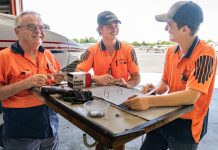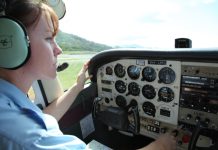As a psychologist who has made a career out of studying organisations, Karl E. Weick might seem an unlikely contributor to aviation safety. But his insights into what organisations are, and how they can improve themselves are just as applicable and useful to an airline, fixed-base operator or flying club as they are to a factory or government department.
Among Weick’s major ideas is the notion of sensemaking. It appears deceptively simple and ‘common-sense’, however, a more complex process is at play. We create, recall and apply patterns from our life experience to make sense of the world around us and impose some sort of order, or categorise it. On one hand sensemaking is the individual process used to support situational awareness (SA) and decision making, we also retrospectively use sensemaking intuitively to make better sense of events or experiences that have already happened. In this sense, sensemaking occurs both during and after events.
Weick used the sensemaking model to re-examine the events and decisions behind a bushfire in the US state of Montana that killed all but three of a 16-person firefighting team. The team leader’s spur-of-the-moment decision to light an escape fire was rare in firefighting at the time, and did not make sense to the rest of the team. They kept running, and mostly died, he stayed in the burned area, and lived.
The sensemaking model provides an alternative to the idea of people and organisations as being rational in their activities and decision-making. To understand the real-world structure and behaviour of organisations, we need to understand the perceptions, assumptions and values of the people who make up the organisation. Sensemaking is, as one disciple of Weick put it, ‘a frame of mind about frames of mind’ that are influenced by emotion, needs and wants.
In the sensemaking view, organisations exist more truly in the heads of their members than in bricks and mortar, or rulebooks and constitutions.
One lesson from Weick’s insights for anyone trying to change or improve an organisation, is that others in the organisation will have their own view of it, and their place in it, which may or may not line up with yours. (Different organisational views are sometimes compatible, sometimes not.) If you want to make sure your changes are understood and acted on, you will have to discover and understand their viewpoints, and you will have to address their concerns.
If you are trying to change your organisation to make it safer, you can use these elements of sensemaking to help make that change happen.
Weick describes several aspects of sensemaking.
It is
- Social, done by people discussing, complaining, joking and questioning with other people. (Does this sound like your organisation’s tearoom?)
Because sensemaking in hindsight involves social processes, changes to the organisation have to include the social elements of explanation and discussion. Announcing a new policy solely through a noticeboard post or email, will not change people’s sense of the organisation and their role in it.
- Identity-based. People’s sense of their organisation and of themselves is linked.
Because sensemaking can be associated with our own identity, organisation members may react with hostility to a change that even unintentionally threatens or disrespects their identity. An injunction to follow standard procedures more closely might be interpreted as an attack on the professionalism of staff, particularly if real-world conditions make following these procedures difficult or impossible.
-
Retrospective. People shape events and experience into meaningful patterns.
Because sensemaking is retrospective, innovations will need time to be absorbed into the structure of meaning in people’s heads. But because it is also ongoing, it can evolve to accommodate new information.
- Cues-based. People will interpret small details and draw large conclusions from them. ‘They look for cues that confirm their analysis; and in doing so, they ignore a great deal,’ Weick says.
Because cues are important, so are symbols and symbolic acts. Keeping the workshop tidy, for example, becomes important, not necessarily for any direct operational reason, but to emphasise discipline and precision and pride in the work. Having top level managers at safety committee meetings is important, not because they can provide all the answers to safety questions, but because their presence there shows the organisation takes safety seriously.
-
Ongoing. Stories should be modified based on new inputs, new opportunities and new setbacks, Weick says (see retrospective above).
- Plausible, rather than always accurate. That which makes sense to a person’s view of the world will be more readily accepted than an inconvenient truth. ‘We seek swift plausibility rather than slow accuracy in inexplicable times simply because we need “an” explanation, not “the” explanation,’ Weick says.
Because sensemaking is based on plausibility, it lends itself to alternative explanations for new situations or ideas. Plausible ideas can be wrong, indeed dangerous, in organisations. An example is the ‘pernicious folklore’ (in the words of Macarthur Job in Flight Safety Australia March-April 2013) that spread in Air Canada about the operation of spoilers on its then-new DC-8 aircraft. This led to a divergence from standard procedures that were directly responsible for a disastrous crash.
In the cockpit, plausibility can mask dangers. Be aware that just because something makes sense doesn’t make it true. Confirmation bias and sensemaking are closely linked, as the case of Singapore Airlines flight 006 shows. That aircraft took off from a closed runway and struck construction equipment on takeoff, killing 85. Yet it was flown by an experienced, trained and conscientious crew who followed standard procedures. Conversely, the truth or the best response to a situation may not make sense, as in the case of the Montana bushfire.
-
Enacted. Weick cautions that sense making is indivisible from the work of an organisation. It comes from doing and thinking in combination. ‘All we have going for us is the tactic of stumbling into explanations that work and talking with others to see whether what we have stumbled into is in fact part of an answer,’ he says.
Sensemaking theory can explain why organisations sometimes make mistakes that affect safety. It also works at an individual level. For accident/incident investigations, sensemaking can be a useful tool to help you understand what occurred in a moment of ambiguity or misinformation.
Sensemaking can point to solutions that you can implement through risk management, training, or ideally, through your safety management system.
Further information
McNamara, L. A. (2015) Sensemaking in Organizations: Reflections on Karl Weick and Social Theory, blog post, Sandia National Laboratories, 2015
Perrow, C (1984) Normal Accidents: Living with High-Risk Technologies. New York, Basic Books
Weick, K. E. (1987). Organizational culture as a source of high reliability. California Management Review, 29, 112–127.
Weick, K. E. (1995). Sensemaking in Organizations. Thousand Oaks, CA: Sage.
Weick, K. E. (2001). Making Sense of the Organization. Oxford, UK: Blackwell.
Weick, K. E., and Sutcliffe, K. M. (2007). Managing the unexpected: Resilient performance in an age of uncertainty. Second edition. San Francisco: Jossey-Bass.





